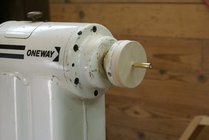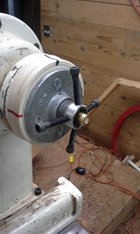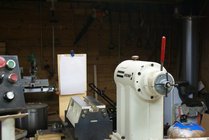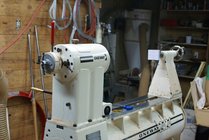probably need a magnetic holder and dial indicator gauge that reads in .0001" (hundred thousandths) or at least thousandths if you aren't anal about absolute precision on things like that (I would be, I'd call my tolerance for runout to be .0003" if it was an expensive lathe) If you set it up right you can check for: first, lateral end play (bearing side play) and if you detect little to none of that, rotating the spindle to check runout... But if there's no runout measuring that way, may have to measure on the shoulder of the spindle (where the faceplates would be seating) to see if there's any waves, nicks, or similar variations which would cause faceplate / chuck to snug up "cocked" to one side (within thread clearance tolerances)
To check for bearing wear you can also put a dial indicator on magnetic base with the indicator touching the top of spindle, put a brass rod into the headstock hole, push down on rod then lift up on the rod and see if there is any reading on the dial indicator. Do you have a mechanics stethoscope ? If so listen to the bearings when lathe is running. I would do the checks Brian said above first.
Just checked before posting and I can see that you have found the source of (and fixed) your problem. Anyway, I'll still post the following in case it helps someone else another time. I can also see that John has given similar advice.....
I am not familiar with the typical issues with that lathe, but I would begin with what Brian and Vincent suggest before thinking about replacing bearings.
If there is visible runout with four
different chucks then I would be thinking that it is more of an issue with the spindle shoulder or thread or shaft... in that order.
First thing I would do is to check to see if the chucks are seating up against the spindle shoulder as that is the area that ensures a good chuck runs true. If not, as Brian suggests, look to see if there are any dings or crud on the shoulder and that the spindle thread looks good. Not that the spindle thread itself ensures that chucks run true, but they can prevent them from doing so if the thread doesn't allow the chuck to pull firmly up against the spindle shoulder.
Worth mentioning is that sometimes the threaded end of the spindle can be longer than the threaded recess in the back of the chuck, which prevents the chuck from properly mating up against the spindle shoulder. Given that your four different chucks have a runout, this is unlikely to be the cause of your problem. But if this appears to be the case, a check for this, and a temporary solution, is to add some flat washers to the spindle until the chucks seats firmly up against them. A more permanent solution to that problem is to either get chucks with deeper threaded recesses or cut off some of the spindle thread so the chucks snug up against the spindle shoulder... a bit drastic, so you would need to be convinced that that is the problem. BTW, you don't need to worry about how precise the cutoff is as it is not the end of the spindle that ensures that chucks run true but the shoulder.
In my experienced you are more likely have noise/heat issues than significant runout from a worn bearing. If you don't have a mechanics stethoscope, use a long screw driver and place the handle end against your ear and the screw driving end against the bearing housing... a worn bearing will have a low growl. The nose bearing is more likely to be worn than the back bearing.
For my purposes a small amount of runout is not an issue for most of what I do as a woodturner, so any of the cheaper dial indicators is more than adequate for my purposes and even a feeler gauge inserted between the chuck face and and the tool rest are more than sufficient to get a meaningful measure.




